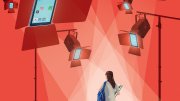In the era of the robbery, night watchmen at the Fogg and the campus police routinely communicated with one another at intervals, but the museum had no bells-and-whistles alarm system. In this it was not alone among museums. In 1979 the Fogg's superintendent, Laurence Doherty, was quoted in the Real Paper as saying, "Up until two years ago, there were museums in this country that never even had their perimeter doors alarmed to ring in a police station. People were very reluctant to spend acquisitions-and-programs money for security, and it's difficult to get endowment money as well. A guy wants a painting up on the wall that says, 'In Memory of Dear Mother Mabel'; he doesn't want his money to go to a security device up on the ceiling."
An early January 1974 memorandum from the Fogg's assistant director, Suzannah Fabing, to director Daniel J. Robbins proves that a fortress mentality had not previously been at work. She summarized "measures taken to strengthen Fogg security during the last five years, up to the time of the coin theft....Beginning in 1970 staffing changes enabled us to add a second guard on the midnight-8 a.m. shift three nights per week," she wrote. "A trained German shepherd guard dog was acquired to patrol with the night watchman; this had to be abandoned because of neighbors' complaints."
The Fogg had always favored open doors--metaphorically speaking. The robbery "was successful," wrote Robbins, "because the Fogg has historically considered itself a working laboratory for the fine arts student, scholar, and interested layman, not a maximum-security prison for works of art." Fabing, who today is director and chief curator of the Smith College Museum of Art, says that security at the Fogg was "consistent with what other museums would have done at the time. It was not way out of line." Professor David Gordon Mitten believes that the coin theft was the largest art robbery any United States museum had suffered. It triggered improvements in security in many museums across the country.
Thieves had shown pre-vious interest in numismatics. Yale University lost coins in May of 1965 (and got them back in 1967). On April 5, 1973, two youths forced open a case in a first-floor gallery of the Fogg and absconded with eight small silver coins, from Greek colonies of the sixth and fifth centuries B.C. in Sicily and southern Italy, worth between $100,000 and $200,000, part of a bequest to the museum made the year before by Frederick Watkins '30. Police caught the culprits trying to sell their booty in Newport News, Virginia. The great plundering of the Fogg would come eight months later.
Fogg officials studied alarm systems, and by June of 1974, they were ready to shut the stable door securely at an estimated cost of a third of a million dollars.
Charles Pearson was not the last hapless watchman to open the door to thieves. In the small hours of a Sunday morning in March 1990, two security guards admitted two thieves dressed as policemen into the Isabella Stewart Gardner Museum in Boston. The thieves tied up the guards and made off with 12 much-loved paintings and a Chinese bronze together valued at $300 million, for the return of which the museum offers a $5-million reward
"A robbery always damages the reputation of a museum," says Fabing. But, she notes, upon learning that the Fogg had been deprived of most of its ancient coins, several benefactors offered their coin collections to the unfortunate museum.





